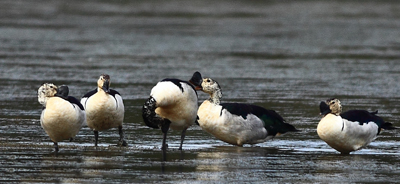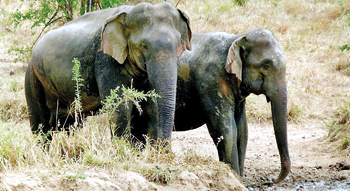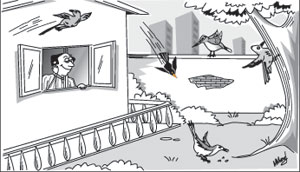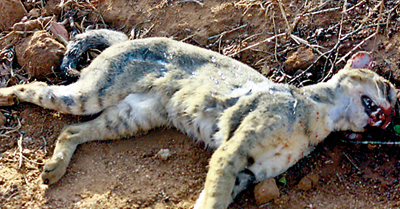Return of the comb duck
By Charundi Panagoda and Duvindi IllankoonThey were on a fairly routine excursion to spot leopards in Rukwila, Yala National Park on June 21. Lallith Ramanayake and good friend Nanda Senanayake were walking around the Rukwila pond to watch leopard cubs when a big goose-like bird flew over their heads.
Mr. Senanayake, who is the President of the Ceylon Bird Club and an “absolute expert on birds” according to Mr. Ramanayake, immediately said, “Lallith, machan, look at this bird. I have a strange feeling that this is a rare comb duck.”
It was unusual to see such a bird in Sri Lanka, Mr. Ramanayake explained, and its greyish wing tips and features fitted the description of the comb duck (now known as the knob-billed duck or scientifically Sarkidionis Melanotos). The bird has been presumed residentially extinct in Sri Lanka for almost a century. There have been no reports of comb duck sightings outside the migratory season either, leading wildlife enthusiasts to believe it would not be seen in Sri Lanka out-of-season again.

Earlier this month on July 4, 5 and 6 five male comb ducks were spotted by wildlife biologist Vimukthi Weeratunga and research fellow Nishantha Bandara at Maththala water tank. Mr. Weeratunga who photographed the birds said it was an extraordinary sight, but it wasn’t unheard of to see five males together.
Just minutes before the duo had seen the duck , Yala safari guide Indika Nettigama had also spotted the same bird, taken pictures and posted on Facebook for ornithologists to identify. The two accounts are the first time comb duck sightings have been verified with photographic proof in over 80 years.
When Mr. Ramanayake ventured out the following day in the hope of spotting the bird again, it was gone. Several bird watchers have since tried their luck but to no avail. It is extraordinary to see the bird off season in June in Sri Lanka, says Deepal Warakagoda, Joint Secretary of the Ceylon Bird Club and lead author of ‘Birds of Sri Lanka’. Birds here are either resident birds or migrant birds, which only arrive during the period between August and April.
The comb duck used to be a resident bird in Sri Lanka in the 1800s, says Mr. Warakagoda. Typically found in the dry lowlands of the northern and eastern areas of the country, the comb duck is described as a “large duck with whitish head specked with black” named after the comb-like bill found on the male’s beak. It resides in dry lowlands and usually nests in tree holes.
In 1955, British ornithologist G.M. Henry declared the bird extinct in his book, ‘A Guide to the Birds of Ceylon’, sometimes considered the ‘Bible’ of bird watching in Sri Lanka. Another British ornithologist, W.W.A. Phillips, wrote the comb duck was “probably extinct in Ceylon.”
However, the duck was seen again, notably in 1960 and 1961 during migration season near Moneragala by local wildlife officer P. Jayawardana, but without any photographic proof. Subsequently, Henry wrote in the second edition of his book the comb duck “did not appear to have been seen for many years and it is feared that it is now extinct in the island”.
Philips updated the status of the bird to “unknown” in 1978. More reports of sightings emerged from Yala in 2002, and in Jaffna in 2002 and 2003, confirming beliefs that the comb duck was sometimes to be seen in Sri Lanka during the migrant season, coming here as stragglers from India (birds who randomly join flocks of other migrant birds). These sightings compelled bird watchers and experts to change the comb duck’s status in Sri Lanka from “extinct” to “rarely seen”.
There are two possible causes for the comb duck’s disappearance during the late 1800s, Mr. Warakagoda explains. One possibility is the loss of their natural habitat; another is the loss of nesting ground due to competition it would have faced from other breeds of duck, which Mr. Warakagoda believes is the more probable of the two.
Environmental lawyer Jagath Gunawardana and bird enthusiast, believes the comb duck was hunted to extinction by the British.
“In the twentieth century, the comb duck was a rather plentiful resident but subsequently it was hunted extensively by the British. It is a large bird and tends to fly slowly therefore easy to spot and shoot. What I believe from observing and studying, it was more extensively hunted than other ducks in the first half of the twentieth century,” Mr. Gunawardana said.
Today, threats to the comb duck’s reappearance in Sri Lanka might come from the vulnerable state of wetlands, the bird’s natural habitat.
“Wetlands in general are threatened in Sri Lanka,” Mr. Gunewardana said. “They are increasingly becoming degraded and destroyed as the lands are used for development purposes. Wetland habitats need to be protected in Sri Lanka.”
Ten out of 12 critically endangered birds in Sri Lanka are thus so because of habitat destruction, he added, especially highland habitats that are being converted to farmlands. Though there have been proposals to protect wildlife habitats better, the government has been slow to take up action, Mr. Gunewardana claimed.
comments powered by Disqus

















